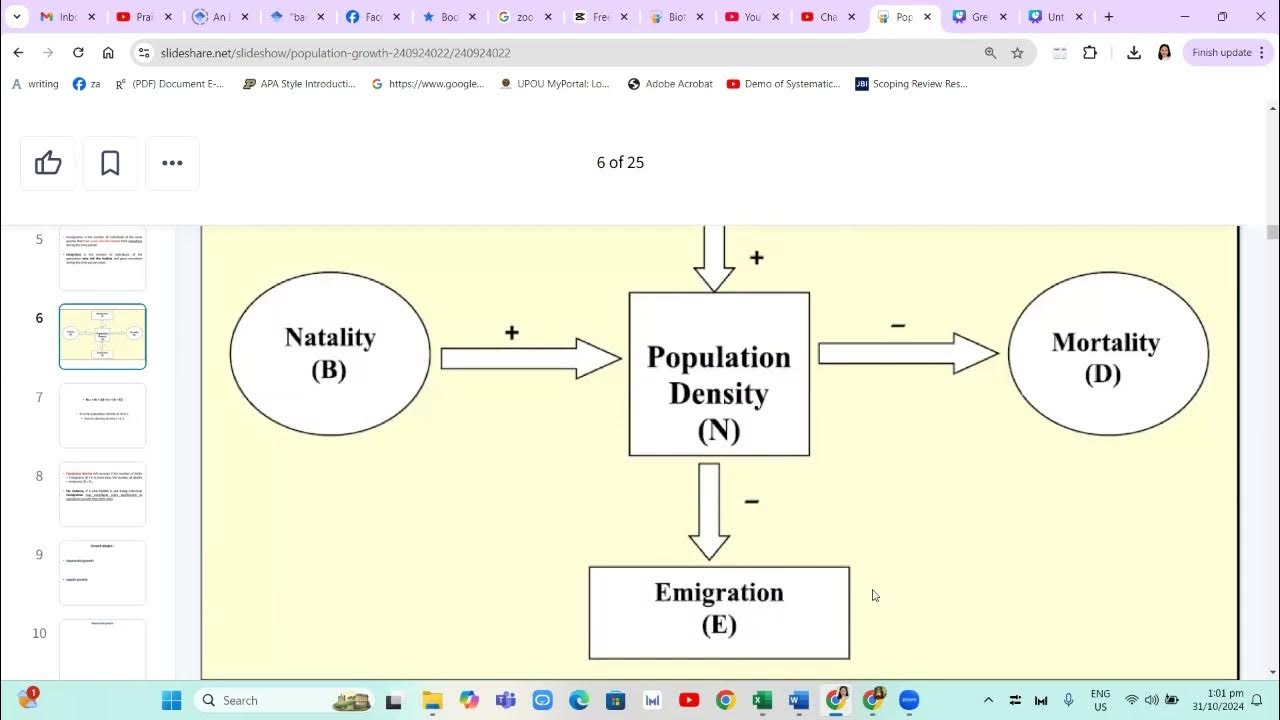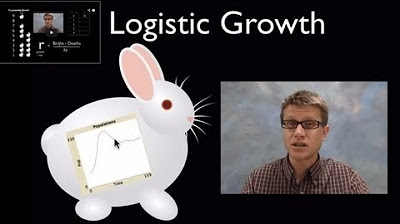Logistic Growth: Overshoot and Collapse
Summary
TLDRThis lesson covers overshoot and collapse in logistic growth models. It explains how populations typically grow towards a carrying capacity but can sometimes exceed it, leading to overshoot. Through examples, the video demonstrates how populations can fluctuate above and below this limit, sometimes stabilizing, but also leading to extreme behaviors like two-cycle and four-cycle patterns. If overshoot is excessive, it can degrade the environment's capacity, resulting in a population collapse. The lesson highlights real-world instances, like lizard populations, where these dynamics have been observed.
Takeaways
- 📈 Logistic growth involves a population growing towards a carrying capacity, which limits its growth.
- 🔢 The carrying capacity in the example is 1,500, with the growth rate adjusting as the population nears this limit.
- 📊 When the growth rate is high, populations can overshoot the carrying capacity, temporarily exceeding it.
- 📉 After overshooting, populations tend to drop back below the carrying capacity, but the population may still stabilize near it over time.
- 🔄 Overshooting can lead to fluctuating population levels, bouncing above and below the carrying capacity in cycles.
- 🔍 A two-cycle population oscillates between a higher and lower value on either side of the carrying capacity, as seen in lizard populations studied in California.
- 🚀 As the growth rate increases, population behavior becomes more extreme, potentially leading to four-cycle or even more complex population cycles.
- 📉 In extreme cases, overshooting the carrying capacity too much can degrade the environment, leading to a population collapse.
- ⚠️ A collapse is a dramatic decrease in the population following an overshoot that severely exceeds the carrying capacity.
- 📚 Cyclical and collapse behaviors are not just mathematical oddities but have been observed in real-world ecological systems.
Q & A
What is the concept of 'overshoot' in logistic growth?
-Overshoot occurs when the population exceeds the carrying capacity due to a high growth rate. This can lead to the population temporarily surpassing the environment's sustainable limit.
What is the carrying capacity in the context of logistic growth models?
-The carrying capacity is the maximum population size that an environment can sustainably support. It acts as a limiting factor for population growth.
How does the growth rate affect logistic growth and the potential for overshoot?
-A high growth rate can push the population beyond the carrying capacity, causing overshoot. This happens because the population grows too rapidly for the environment to support.
What is a 'two cycle' in population dynamics?
-A two cycle occurs when the population alternates between two levels: one above and one below the carrying capacity. This pattern can continue over time, reflecting periodic fluctuations in population size.
Can overshoot lead to long-term consequences for a population?
-Yes, significant overshoot can degrade the carrying capacity, resulting in a population collapse. This is a dramatic decrease in population size due to unsustainable environmental conditions.
What is the 'recursive logistic growth equation' mentioned in the script?
-The recursive logistic growth equation models population changes over time, accounting for both growth rate and carrying capacity. It helps predict future population sizes based on current values.
What happens when the initial population is close to the carrying capacity?
-If the initial population is close to the carrying capacity, the growth rate may cause the population to overshoot slightly before stabilizing near the carrying capacity, as seen in the second example in the script.
What is meant by 'collapse' in the context of population dynamics?
-Collapse refers to a severe decline in population size following a substantial overshoot. It happens when the environment's carrying capacity is significantly degraded, no longer supporting the previous population level.
How do four cycles and other higher-order cycles relate to logistic growth?
-Higher-order cycles, like four cycles, occur when the population fluctuates among more than two levels. These complex patterns arise when the growth rate is extremely high, causing unpredictable oscillations.
Can you provide a real-world example of a two-cycle pattern in nature?
-Yes, researchers from the University of California observed a stable two-cycle pattern in a lizard population in California, where the population alternated between two distinct levels over time.
Outlines

このセクションは有料ユーザー限定です。 アクセスするには、アップグレードをお願いします。
今すぐアップグレードMindmap

このセクションは有料ユーザー限定です。 アクセスするには、アップグレードをお願いします。
今すぐアップグレードKeywords

このセクションは有料ユーザー限定です。 アクセスするには、アップグレードをお願いします。
今すぐアップグレードHighlights

このセクションは有料ユーザー限定です。 アクセスするには、アップグレードをお願いします。
今すぐアップグレードTranscripts

このセクションは有料ユーザー限定です。 アクセスするには、アップグレードをお願いします。
今すぐアップグレード5.0 / 5 (0 votes)






